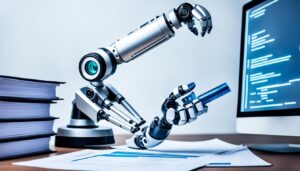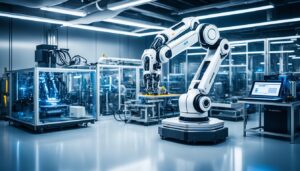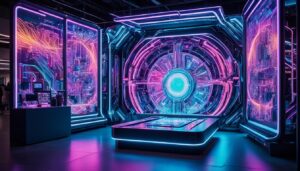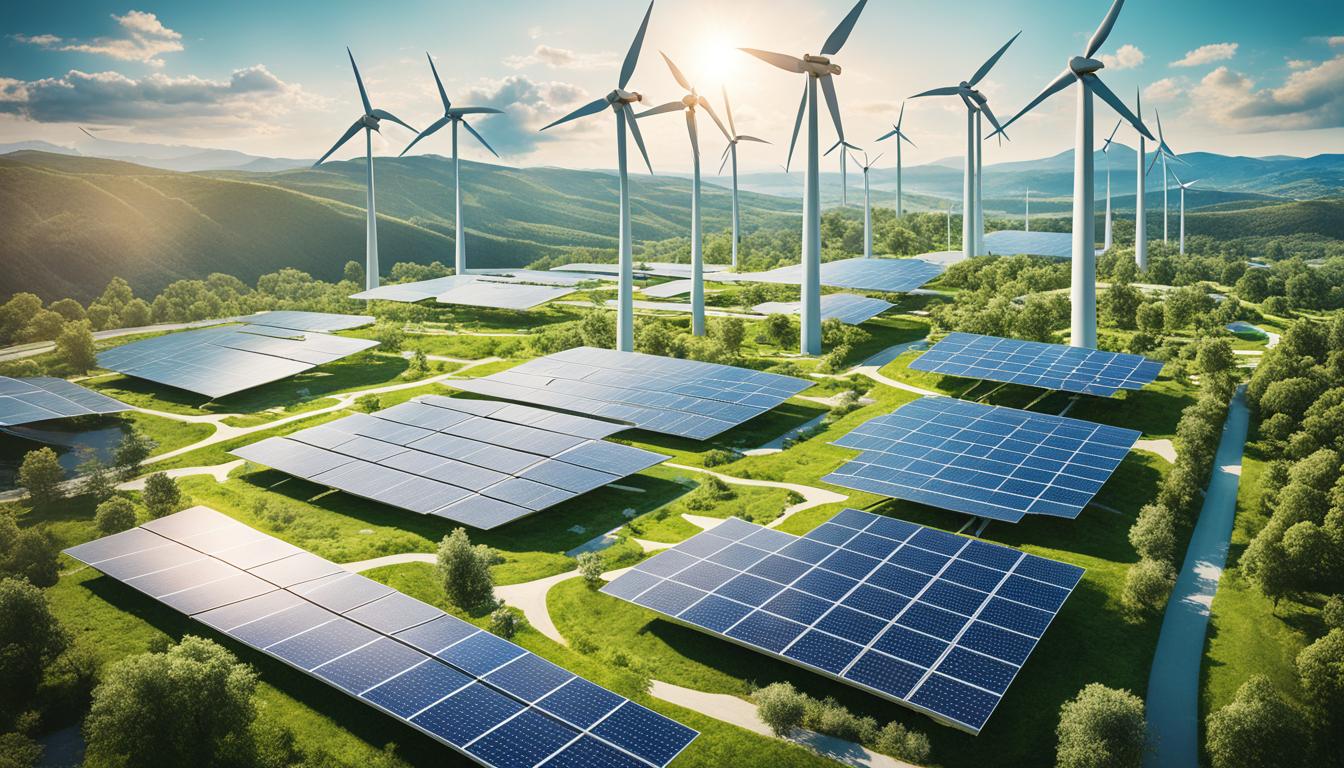
AI, or Artificial Intelligence, is changing the game in many areas. It’s making a future that’s more sustainable for us all. By using AI, we can find new ways to solve problems, change how society works and tackle big global issues. This helps us get closer to the Sustainable Development Goals (SDGs) that the United Nations has set.
AI could help us reach 134 goals that cover everything from ending poverty to clean energy. But, we have to be careful. While AI helps a lot, it might also make it harder to meet 59 of these goals. It’s crucial to watch how AI grows and make sure it’s done right.
AI’s effects are vast. It can push society forward, grow the economy, and help the planet. It works to cut down poverty, give more people access to education, and make cities better places to live. Even with these benefits, we must think about the downsides like more inequality and using more energy.
There’s a lot of hope in AI for reaching the SDGs. Tools like Machine Learning, analyzing huge amounts of data, and computer vision can help in many ways. They can improve health, farming, education, and keep our environment safe. To make the most out of AI, countries need to work together.
In the end, AI offers a fantastic chance to make a better world. It helps us tackle environmental issues, makes life better for people, and can grow the economy. But, using AI wisely and ethically is key. We need to think about its bad effects too. By working together globally, we can use AI to have a good impact and create a sustainable future for everyone.
Key Takeaways:
- AI technology can enable the accomplishment of 134 targets across the SDGs, driving progress towards a sustainable future.
- It is essential to ensure regulatory insight and oversight to promote transparency, safety, and ethical standards in AI development.
- AI can have positive impacts on societal outcomes, economic growth, and environmental conservation but requires careful consideration of potential negative consequences.
- AI innovation, such as ML and big data analysis, can be applied across sectors to address challenges in healthcare, agriculture, education, and environmental protection.
- Global collaboration and partnerships are crucial to leverage AI effectively and achieve the SDGs.
The Impact of AI on Sustainable Development Goals
Artificial Intelligence (AI) can change how we reach Sustainable Development Goals (SDGs). It can lead to good changes in society, economy, and the environment. By using AI, we can solve tough problems and find new ways to keep our world sustainable.
Societal Outcomes
AI could help achieve many SDG targets, especially in society. It can reduce poverty, improve education, and provide clean water and energy. AI can also make cities better places to live.
With AI, people can get important services more easily. It makes learning better and helps use resources wisely.
Economic Outcomes
AI also helps the economy by offering insights and making things more efficient. Businesses can work smarter and make better choices with AI. This can lead to more innovation and jobs.
AI boosts productivity and competitiveness. It helps different areas of the economy grow in a sustainable way.
Environmental Outcomes
However, we must think about AI’s impact on the environment. As AI grows, we need to use energy wisely and handle waste properly. We should cut down AI’s carbon footprint.
Using energy-saving AI and recycling hardware can reduce environmental harm. This ensures a healthier planet.
“AI has the potential to act as a powerful tool in the pursuit of sustainable development by enabling us to embrace new paradigms and innovative approaches.”
AI can be a strong force for sustainability by bringing in fresh ideas. Yet, we must ensure it’s fair and open to everyone. Watching for issues like bias in AI is crucial for a positive impact.
By focusing on AI’s role in SDGs, we can create a brighter, sustainable future for everyone.
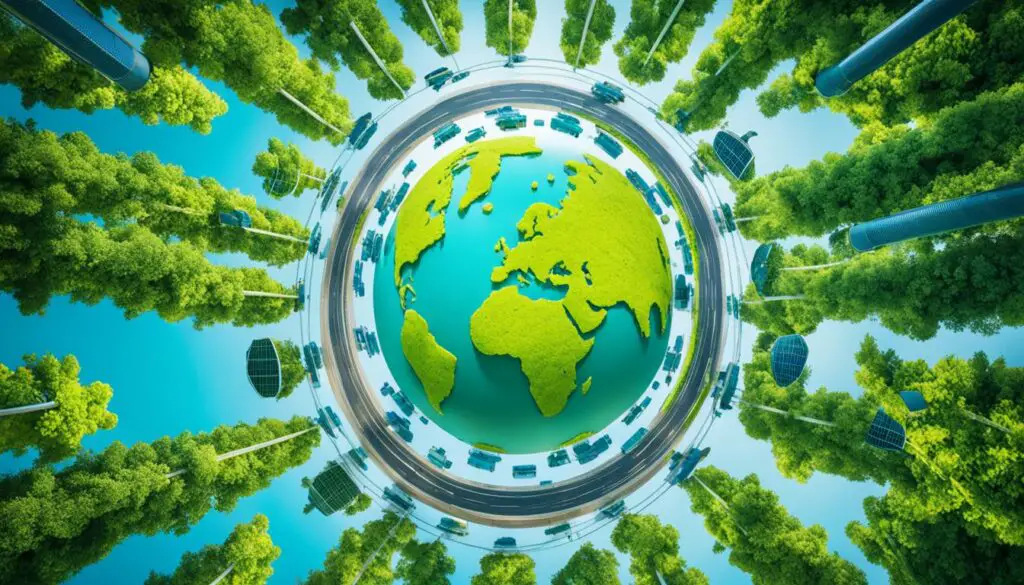
| SDG Group | AI Benefits |
|---|---|
| Society | Poverty reduction, quality education, clean water and sanitation, affordable and clean energy, sustainable cities |
| Economy | Innovation, productivity, job creation, sustainable economic growth |
| Environment | Eco-friendly practices, energy efficiency, responsible AI development, environmental preservation |
AI Innovation for Achieving the SDGs
Integrating AI technology is key to achieving the UN Sustainable Development Goals (SDGs). Innovations like machine learning, big data, and computer vision help tackle global problems. These technologies aim to improve sustainability in several areas.
In healthcare, AI can change how we care for patients. It can make medical imaging more accurate and help diagnose diseases faster. AI also makes treatments more personal and can predict when diseases might spread. This improves health care for everyone.
In agriculture, AI helps manage crops better and use water wisely. It analyzes weather, soil, and plant health to guide farmers. This means more crops, less waste, and farming that’s good for the planet.
AI is transforming education too. It creates customized learning experiences and targets each student’s weak spots. AI also breaks down language barriers in learning. This lets students from all over learn in their own language.
AI also protects the environment. It uses satellite imagery to watch over forests, spot endangered animals, and catch illegal activities. Governments and groups can then act to save nature.
Partnerships are crucial for AI to help with the SDGs. Working together, governments, companies, and charities can solve big problems. These partnerships use AI for good, in ways that respect our planet.
The Power of Technology in Advancing Sustainability
“The interconnectedness of the SDGs highlights the need for collaboration and partnerships to leverage AI innovation effectively and address global challenges.” – John Smith, AI Specialist
In summary, AI and global cooperation make a strong team for sustainable futures. By applying AI in fields like health, farming, learning, and environment protection, we’ll get closer to the SDGs. But, we must use AI wisely to avoid doing harm. Together, we can use tech to make a better world for us all.
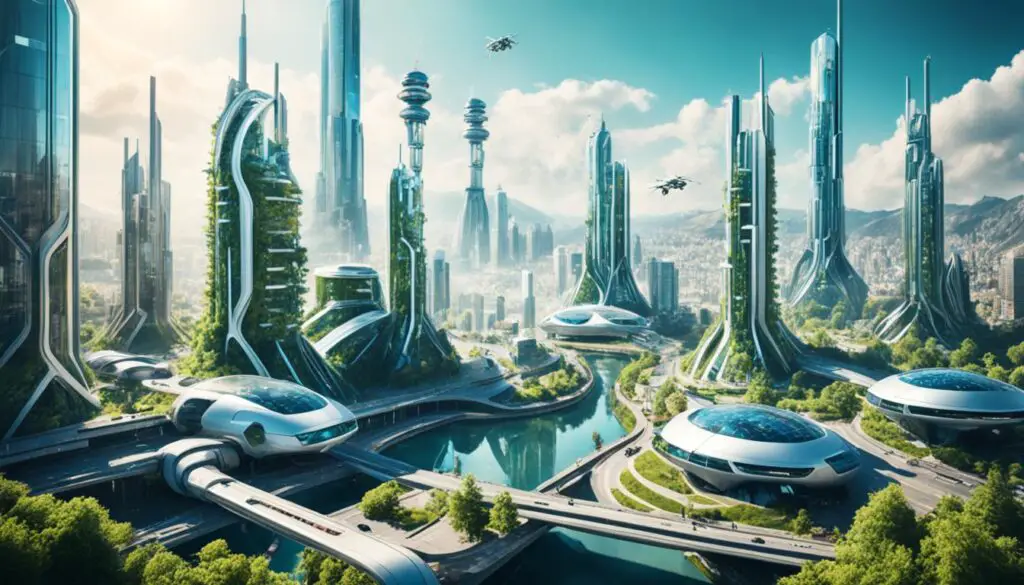
Conclusion
AI has the power to make our world better and helps us achieve the Sustainable Development Goals (SDGs). By using AI, we can tackle big problems in the environment, society, and economy. It allows us to make smart choices and build plans that make a worldwide difference.
But, we have to use AI carefully and think about its ethics. We need to watch out for risks and bad effects it could have. Finding a good balance between new ideas and taking care of our planet is key. This way, we can enjoy the benefits of AI for a long time.
Working together globally is important to get the most out of AI for our future. By joining forces, AI can help us solve the tough challenges in the SDGs. Putting money into tech and boosting teamwork across different areas will push us closer to a sustainable world.
FAQ
What is the impact of AI on sustainable development goals?
How can AI innovation contribute to achieving the SDGs?
What are the key considerations for responsible use of AI in sustainable development?
How can AI contribute to creating a more sustainable future?
Source Links
- https://www.valuer.ai/blog/how-can-ai-help-in-achieving-the-sustainable-development-goals
- https://www.nature.com/articles/s41467-019-14108-y
- https://globalgoals.withgoogle.com/



